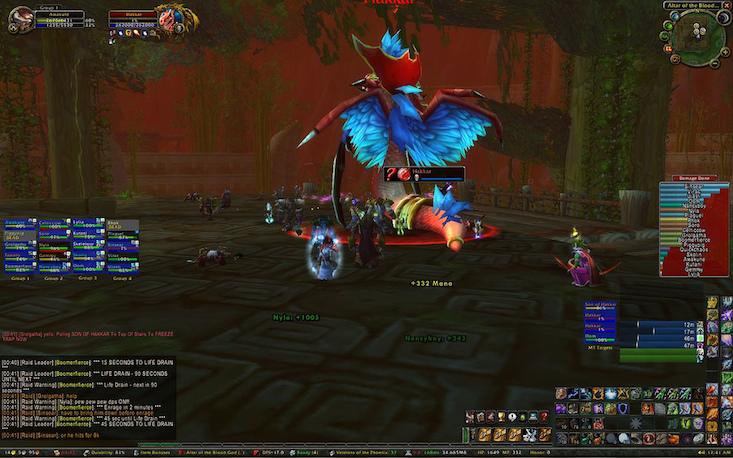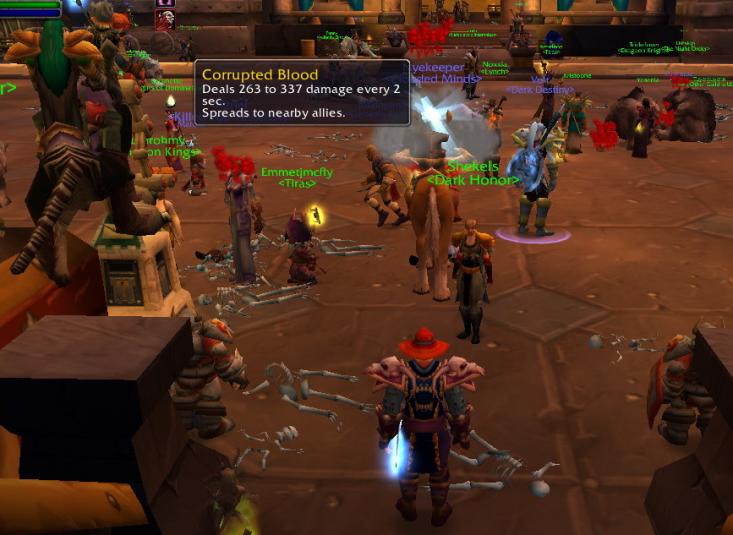On Sept. 13, 2005, Nick Yee died. A few moments later, he came back to life. Then he died again.
And he wasn’t the only one. His city was littered with bodies, bones scattered across the floor of the auction house and town square. “It was simply hilarious,” he said, “that everyone was dying and no one was sure what was happening.”
It was hilarious because the Nick Yee that died wasn’t really Nick Yee. It was his avatar, a Night Elf in World of Warcraft, an online role-playing game played by millions of people around the world. Yee’s Night Elf died of a sickness called Corrupted Blood, which had quickly spread from a single dungeon to several servers, infecting millions of players and bringing the game to a crashing halt.
In another part of the world, a Night Elf Druid logged on and started walking toward the main city. He had heard that something was going on, some kind of outbreak, and he wanted to see it for himself. In front of him lay the same kinds of skeletons Yee had seen, piles of blue bones littered across the landscape. Nearby, infected characters were emitting bursts of bright red blood, accompanied each time by a splurting sound, every few seconds. The player controlling the Night Elf Druid, Eric Lofgren, picked up the phone and called Nina Fefferman. “You should log in,” he said. “That thing we were talking about is actually happening.”
Fefferman looked around for a few minutes at the confusion. She then quickly logged off, picked up the phone, and called Blizzard Entertainment, developers of World of Warcraft.
The Corrupted Blood Incident lasted for only a few days, but its impact continues beyond the realm of Azeroth, in laboratories in the physical world. At the time, Fefferman and Lofgren both worked at the Department of Health and Family Medicine at Tufts University School of Medicine. Large-scale behavioral studies on outbreaks are logistically impossible or ethically problematic, but the game provides them with an opportunity to model what people might do in a real-life pandemic. These models, in turn, can inform public health officials on what to be ready for and how to react.
Or at least in theory they can. Using game data to make inferences about the real world can be tricky business. Questions still remain about how much games like World of Warcraft can tell us about the complex relationships and chains of events that happen in things like outbreaks and pandemics. A recent study looking back at Feffernan and Lofgren’s analysis offers some cautions about using game behavior to think about real-world outbreaks. Does someone riding a flying griffin react the same as a kid riding a city bus when infected with a deadly illness? No one really knows, but answering that question could help scientists figure out whether online games are a valuable tool for figuring out how to fight disease outbreaks.
A Disease Escapes
Today World of Warcraft (WoW) is the largest online role-playing game in the world. Like other massively multiplayer online role playing games, or MMORPGs, WoW allows hundreds of thousands of players to interact with the world and each other at the same time.
When you start playing World of Warcraft, you pick a side (the valiant Alliance or the devious Horde), create a character, and join a guild. Gameplay is heavily dependent on these groups—teams of anywhere from 50 to hundreds of players—and it is with these guild members that you complete challenges, called raids. It was one raid in particular that set the Corrupted Blood Incident in motion.
Sept. 13, 2005. A brand new dungeon area called Zul’Gurub was opened as part of a game update. Zul’Gurub was controlled by a boss named Hakkar—a giant serpentine dragon with broad, sweeping wings and flowing blue hair. He stood, perched on a thick tail, with two long, gleaming scyth arms at the back of the dungeon, waiting for players to venture inside.

As guilds raided the dungeon, Hakkar cast a set of spells with menacing names like Blood Siphon, Insanity, and the soon-to-be-infamous Corrupted Blood. A player infected with Corrupted Blood would slowly lose health, spurting blood as he, she, or it slowly got sicker and sicker. Corrupted Blood is such a virulent sickness that only high-ranking players could survive for any significant length of time. Low-ranking players died almost immediately, their skeletons falling to the ground. Once players in a guild were infected with Corrupted Blood, they invariably gave the disease to anyone standing near them. “It’s ludicrously contagious,” Lofgren says. “If you’re close to someone who has this disease, you’re guaranteed to get it.”
To powerful players battling Hakkar, the disease was inconvenient. It slowed them down and made it harder for the team to complete the raid. But then something unusual happened: The disease escaped the dungeon.
Players in the World of Warcraft can teleport—vanish from where they are and reappear somewhere else. Players who teleported out of Zul’Gurub while infected with Corrupted Blood brought it with them—something a disease like that isn’t supposed to be able to do. The escape was a glitch in programming, something the designers missed when testing the new boss.
What made things worse was that teleportation is most commonly used to get to cities—big capitals where players can buy and sell items, and one of the few places where high- and low-level players meet and interact. So when infected characters teleported from Zul’Gurub to Ironforge or Orgrimmar, Corrupted Blood came with them. Within a few hours, Ironforge was full of skeletons and characters wandering around, dazed and spurting blood.

Blizzard Entertainment, WoW’s maker, was suddenly in emergency mode. To them, this was a bug in an entirely different sense of the word. They issued statements to players, asking them not to summon infected pets in crowded areas, and to leave the city areas if they were infected. But the disease continued to spread.
After a few days Blizzard tried to quarantine infected players within the game—rounding them up and moving them to an area of the world away from other characters. But many players didn’t cooperate, or didn’t know where they were supposed to go. In response, a group of players formed an in-game militia to enforce the quarantine. But that didn’t work either. Corrupted Blood was still spreading.
Eventually Blizzard had enough. They pulled the plug—literally. Blizzard shut down the servers infected by Corrupted Blood and reset everything to the way it was before the outbreak started. When players logged in after the reset, the piles of skeletons were gone. People began returning to their daily lives, coming back to the main cities and getting back together with their teams. Eventually, everything returned to normal.
It’s not clear exactly how many players were infected with Corrupted Blood, but after a few days the disease had spread to several different servers at Blizzard that ran WoW. Some players estimate that the disease was affecting 4 million players in total.

A Window Into the Human Mind
When Fefferman logged off WoW during the Corrupted Blood plague to call Blizzard, she was already thinking about what kinds of data she wanted. When she got Blizzard representatives on the phone, Fefferman says, it was eerily similar to the times she’s talked to the CDC during an outbreak. “They were in the middle of emergency spin control,” she recalls.
But Blizzard didn’t keep data on any of the questions she was asking: Where players were, how they moved around, what spells they cast, who they were fighting. So Fefferman and Lofgren started collecting player accounts from forums and YouTube videos, trying to figure out what kinds of things people did to avoid or perpetuate the outbreak. They wanted to know how people reacted to the disease, and what informed those reactions.
Fefferman says that this outbreak had more in common with real-world diseases than one might expect. It originated in an animal (Hakkar) in a remote region (Zul’Gurub), was carried to urban areas by travelers (players), and was spread through close contact. Its hosts were both animal and human, and just like in real plagues, some carriers were asymptomatic.
But there were other parts of the disease that weren’t realistic at all. Catching Corrupted Blood was far too easy; the guaranteed transmission between two characters that got close enough is unlike that for even the most infectious diseases in the real world. Moreover, epidemiological models are pretty good at figuring out how disease spreads mechanically once you understand host behavior. “There are very good scientific techniques for understanding what disease spread should look like in the real world,” Fefferman says. “We know how to do that part.”
It’s the host behavior part that researchers don’t completely understand. That is, they don’t know how people will actually act when that plague breaks out. Doing studies on large outbreaks is hard; the relevant information tends to be scattered and disorganized. And intentionally infecting people to see what happens is, of course, ethically impermissible.
So when Fefferman and Lofgren looked at what the players were doing, they were really trying to figure out how to improve their current behavioral models in general. Basically, they wanted to know which behaviors they had accounted for and which they hadn’t.
Some of the player behaviors were what they expected to see. They saw people who were scared and ignored public health announcements. They saw people who were scared and were seeking out public health announcements—the equivalent, Fefferman says, of those who call the Department of Public Health asking for answers. They saw people rushing in, trying to help and heal the sick—as aid workers would. And they saw a lot of discussion, with players talking to one another about what to do, where to go, and whether to be really worried. “Like people who talk to their neighbors,” Fefferman says.
But the scientists also saw behaviors they hadn’t thought to build into their models before. Fefferman and Lofgren were both curious about the disease, and so exposed their WoW characters to it to see what was going on. “That’s something we [had] never put into the epidemiological model,” Fefferman says. While it might seem unrealistic for people to put themselves at risk of a disease out of curiosity, Fefferman says it’s not all that farfetched. Journalists, for example, might get closer to an outbreak than they should to find out what’s going on. So might public health researchers.
Then there was what gamers call “griefing”—the practice of intentionally making things harder for other players. In this case, high-level players who could survive the plague would intentionally go around infecting other, lower-level characters for fun or other reasons. While uncommon, this behavior isn’t unheard of in real life.
But there are also less dramatic examples of unintentional griefing: people who go to work when they’re sick. “It’s not malicious,” Lofgren says, but people with the flu who go to work—because they’re out of sick days or they have a big deadline coming up—are knowingly exposing their coworkers to disease.
Since the Corrupted Blood incident, this insight has shown up in Lofgren and Fefferman’s work. “It has resulted in a pretty heavy emphasis, at least in my own research, about considering and accounting for host behavior and how people react to outbreaks, rather than assuming they’re perfectly well-behaved rational actors,” says Lofgren. In his research on preventing infections in hospitals, for example, his model now includes nurses and doctors who forget to wash their hands. And when it comes to designing better prevention for these infections, Lofgren has begun to emphasize measures that don’t rely on human behavior, which can never be fully purged of unreliability and irrationality. So instead of depending on nurses to wash their hands, it might be more effective to change the way the hospital is designed and what materials it uses.
Scrutinizing a Reflection
Not all investigators share Fefferman and Lofgren’s enthusiasm for using WoW to gain insights about epidemiology. Making inferences from video games is tricky, and knowing exactly which behaviors do and don’t transfer from games to reality is difficult.
Researchers know that some very basic behaviors are “conserved,” or accurately repeated, in video games. Traits like how close someone stands to another person correlate well between the game and real life. The same goes for how long a person gazes at something. Nick Yee, the unfortunate Dark Night Elf, was also a virtual reality researcher, at the Palo Alto Research Center. In his work he has found that if your avatar is tall, you’re more likely to be confident in real life, too.
The question remains, however, how far you can go along the behavioral spectrum. Basic instincts and body posture might be conserved in games, but higher-level thinking is trickier to pin down. “If I whip a ball at your head, you’re going to flinch whether it’s a real or virtual ball,” says Jeremy Bailenson, the director of the Virtual Human Interaction Lab at Stanford. “But if I ask you to marry me, you’re probably going to consider that, because it’s an important, thoughtful decision.”
Bailenson, who has spent years looking at the crossover between virtual worlds and reality, argues that a disease like Corrupted Blood is more akin to the ball than to the proposal. Characters are concerned for their survival, he argues, which involves a very primal and deeply rooted instinct.
But dying in a game is simply not the same thing as dying in real life, says Edward Castranova, a virtual-worlds researcher at Indiana University in Bloomington. He likens the attachment to our love for our pets. Your pet dying carries a cost, he says, but it’s simply not the same as the cost of you yourself dying. “It’s just not the same mental process.”
Fefferman and Lofgren agree, at least to some extent. In their study, they say, they were not trying to make a one-to-one correlation between events in the game and real-world human behavior. “It’s not realistic,” Lofgren says. “I don’t think I or anyone would really say you can take these results, cut and paste them into the real world, and this will work out.” Instead, they’re looking for broader classes of information about how people might behave, and which factors change how people behave.
In their perfect world, Lofgren and Fefferman would use video games in a more controlled way to study outbreaks. Instead of watching a one-off accident like Corrupted Blood, they would tinker with the variables and run the simulation again and again. Fefferman and Lofgren couldn’t even get a lot of the data they hoped for, because Blizzard doesn’t keep information about where all its players are all the time. Instead, they were watching an outbreak happen and observing the chaos that ensued without being able to know what was really driving things. In that way, the virtual outbreak was frustratingly similar to ones in the real world. But World of Warcraft isn’t a sandbox made for the experiments of scientists—it’s a game, made for the enjoyment of its players and profit of its creators, and it will remain difficult to study.
“All models aren’t perfect reflections of reality,” Lofgren says. “This is good at looking at the chaos of human reactions to things, even though it’s not perfectly realistic.”
This article originally appeared on our blog, Facts So Romantic, in May 2014.



